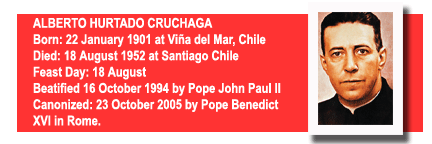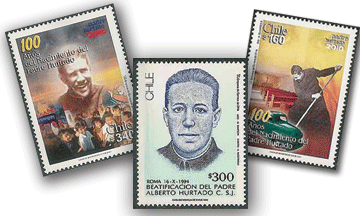A Priest, I Bless You - Alberto
Fr John Griffin, a Columban ordained in 1950, worked for many years in Zambales. He was later assigned as a missionary in Chile. At present he works in Lower Hutt, near Wellington, the capital of his native New Zealand.

The name of Chilean Jesuit priest Alberto Hurtado, who succumbed to pancreatic cancer in Santiago, Chile, on 18 August 1952, has long been nationally venerated, but now more than ever following his canonization by Pope Benedict XVI in 2005. He is Chile’s second saint, following the canonization in 1995 of Sta Teresa de Los Andes, a young Carmelite novice.
The saint’s father was murdered by rustlers when Alberto was only four. This forced his mother to sell the farm, settle all debts and move with her two small sons to Santiago. There they depended on the charity of her brother and other relatives who took turns in sheltering them and giving them a home.
At eight years of age Alberto gained a scholarship to San Ignacio College, administered by the Jesuits, and he was there for the next nine years. He and his classmates deeply admired one of their teachers, Fr Fernando Vives.
He was a man who took seriously the social implications of the Gospel teachings and of the Encyclical Letter of Pope Leo XIII, ‘Rerum Novarum’ and he instilled a lasting social conscience in most of his students.
Prior to graduating from San Ignacio in 1917, Alberto applied to enter the Jesuit Novitiate, but since he was only 16 he was advised to wait. He began to study law at Santiago’s Catholic University. In August 1923 he was admitted to the Jesuit Novitiate located in Chillan, 400 kms south of Santiago, and two years later was sent to Argentina to continue his spiritual formation. This meant a painful separation from his widowed mother whom he was not to see again until 11 years later.
For the study of theology the group was sent to Louvain in Belgium and there Alberto was ordained on 24 August 1933. He conveyed this good news to his mother in the simplest of telegrams, ‘A priest, I bless you – Alberto’ and returned to Chile at the beginning of 1936.
Following a joyful month’s holiday with his mother and family in Santiago he received his assignment – back to the scene of his secondary studies, San Ignacio College. He also became a part-time professor at the Archdiocesan Major Seminary and the Catholic University.
Overall, Fr Hurtado is best known and remembered throughout Chile for his ‘Hogar de Cristo’ (Christ’s Home) Foundation. The seed for this was sown late one night when he was on his way home to San Ignacio. He met a man who was in poor health, had eaten nothing all day and had nowhere to go.
This was the priest’s first encounter with such poverty and it moved him greatly. He did what he could for the man and then asked: ‘What are our Catholics doing for those who have no roof over their heads?’ He began asking this question during his retreats and so was born the idea of ‘Hogar de Cristo’. He formed a board of directors from people eager to help – six men and 30 women. Land was available alongside the Jesuit parish of Jesus the Worker and the first night-shelters were built and an appeal for funds began. By 1945 there were five shelters that had been able to house 12,000 poor men. Now it was time to do something for the numerous ‘street kids’ who spent their nights under the many bridges over the Mapocho River which runs for miles through Santiago. These youngsters needed educations as well as shelter and land was donated for this purpose a few miles to the north of the city near Colina railway station and a children’s home was built.
It was immediately obvious that such youngsters needed some sort of a trade to make their future secure, so different workshops were built. Fr Hurtado was confronted by another question: ‘How many such homes and workshops are needed up and down Chile to tackle the problem of child vagrancy?’ Something, he said, that should be of concern to all Chileans.
Providence was always on his side. At a meeting one night his board of directors was unwilling, for lack of funds, to approve a new project. In the midst of discussions there was an unexpected call for Fr Hurtado to attend to someone at his front door. He had a brief conversation with the caller who said she wanted to leave a gift to help the great work he was doing.
He gratefully put her envelope in his pocket, wished her a good evening and returned to his meeting. He looked at the contents of the envelope as he sat down. Then he tossed a check onto the table saying, ‘There you are, ye of little faith!’ It was for one million pesos – worth about US$30,000 at that time.
Through radio talks, public lectures and articles in the press, Fr Hurtado appealed untiringly in the name of the ‘Home of the Homeless’. He acquired a green truck that became well known around Santiago as he went looking, especially on winter nights, for ‘clients’ whom he would take to a coffee shop for something hot, then drive them back to where a clean, warm bed was waiting for them.
Suddenly, in April 1952, his health began to deteriorate. He took a couple of rest periods but there was no improvement. Friends convinced him to see a doctor who made several tests that revealed that he had cancer of the pancreas. On 19 May he celebrated the Eucharist at San Ignacio but this proved to be his last Mass as later that day he suffered a serious heart attack and was taken to the hospital of the Catholic University.
Word spread quickly and a continual stream of visitors came to see him. His great delight was to receive his earlier waifs and strays, many of whom were by now successful businessmen. His peaceful death took place in the late afternoon of 18 August 1952.
On 5 November 1991 the late Pope John Paul II declared him ‘Venerable’ and then ‘Blessed’ on 16 October 1994. Pope Benedict XVI declared him ‘San Alberto’ on 23 October 2005.

You may email the author at
jgriffin@paradise.net.nz or write him
at: St Columban’s, PO Box 30-017,
LOWER HUTT 5040, NEW
ZEALAND
